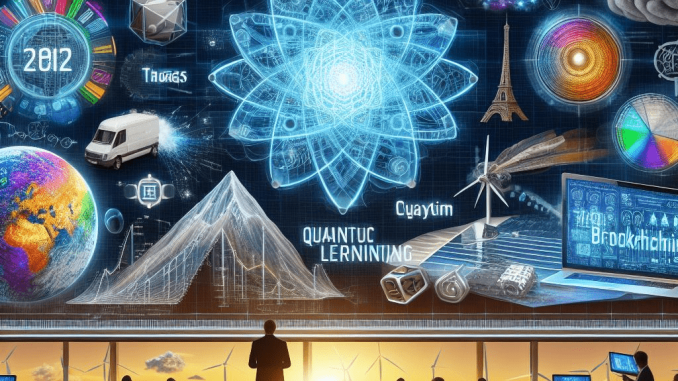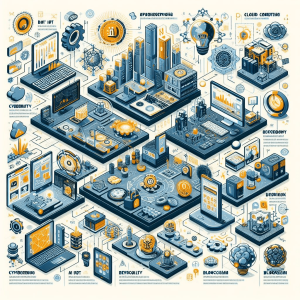
Trends in Electrical Engineering and Information Technology You Should Know
Introduction
In the dynamic realm of Electrical Engineering and Information Technology, advancements occur breathtakingly. From groundbreaking discoveries to revolutionary technologies, staying abreast of the latest trends is paramount for professionals and enthusiasts alike. In this article, we delve into seven cutting-edge trends reshaping the landscape of Electrical Engineering and Information Technology, offering insights into their significance and potential impact.

Artificial Intelligence and Machine Learning Integration
Artificial Intelligence (AI) and Machine Learning (ML) have emerged as transformative forces across various industries. In Electrical Engineering and Information Technology, integrating AI and ML revolutionizes processes, enabling autonomous systems, predictive analytics, and enhanced decision-making capabilities. From optimizing power grids to refining communication networks, the synergy between AI and ML drives unprecedented innovation and efficiency
Internet of Things (IoT) Revolution
The Internet of Things (IoT) is ushering in a new era of connectivity, where devices seamlessly communicate and interact. In Electrical Engineering and Information Technology, IoT applications span a wide spectrum, encompassing smart homes, industrial automation, healthcare systems, and more. IoT is fostering greater efficiency, productivity, and convenience in various domains by facilitating data exchange and enabling real-time monitoring.
Renewable Energy Technologies
As sustainability becomes a focal point globally, the adoption of renewable energy technologies is gaining momentum within Electrical Engineering and Information Technology. Innovations in solar power, wind energy, and hydroelectric systems are driving the transition towards cleaner and more environmentally friendly energy sources. These advancements mitigate the impact of climate change and present new opportunities for energy generation and distribution.

5G Networks and Beyond
The advent of 5G technology heralds a new era of connectivity characterized by unprecedented speed, reliability, and low latency. In Electrical Engineering and Information Technology, the rollout of 5G networks is poised to revolutionize communication infrastructures, enabling immersive experiences, IoT proliferation, and advancements in autonomous vehicles. Beyond 5G, research efforts are already underway to explore the potential of 6G and beyond, promising even greater connectivity and innovation.
Cybersecurity Paradigm Shift
With the proliferation of digital technologies, cybersecurity has become a paramount concern in Electrical Engineering and Information Technology. Traditional approaches to cybersecurity are evolving to address emerging threats such as ransomware, phishing attacks, and data breaches. From encryption algorithms to biometric authentication, novel strategies are devised to safeguard critical infrastructure, sensitive information, and personal privacy in an increasingly interconnected world.
Edge Computing Innovations
Edge computing represents a paradigm shift in data processing, where computational tasks are performed closer to the data source rather than relying solely on centralized cloud servers. In Electrical Engineering and Information Technology, edge computing offers significant advantages in reduced latency, bandwidth optimization, and enhanced scalability. By enabling real-time data analysis and decision-making at the network periphery, edge computing paves the way for transformative applications in IoT, autonomous systems, and augmented reality.
Blockchain Disruption
Blockchain technology has transcended its origins in cryptocurrency to become a disruptive force across diverse industries, including Electrical Engineering and Information Technology. Blockchain offers unparalleled transparency, security, and trust by providing a decentralized and immutable ledger for transactions and data management. In fields such as smart grids, supply chain management, and digital identity verification, blockchain holds the potential to streamline processes, eliminate intermediaries, and foster greater accountability.
Frequently Asked Questions (FAQs)
How are AI and ML transforming Electrical Engineering and Information Technology?
AI and ML are revolutionizing Electrical Engineering and Information Technology by enabling autonomous systems, predictive analytics, and enhanced decision-making capabilities.
What are the key benefits of IoT adoption in Electrical Engineering and Information Technology?
AI and ML, two transformative technologies, are profoundly reshaping the landscape of electrical engineering and information technology (IT). In electrical engineering, AI and ML algorithms optimize power synthesis efficiency and ensure energy distribution. These technologies enable predictive maintenance of electrical grids, allowing engineers to preemptively address potential faults and minimize downtime, thus ensuring minimized power supply to consumers.
Moreover, AI and ML are revolutionizing the design and oprevolutionizinglectronic circuioptimizationnents. Engineers can streamline the development process, improve performance, and reduce costs through advanced algorithms. From designing complex integrated circuits to optimizing signal processing, optimizing ML techniques empowers engineers to push the boundaries of innovation in Electrical Engineering.
In Information Technology, AI and ML algorithms drive data analysis, cybersecurity, and network management advancements. These technologies are pivotal in detecting anomalies, identifying potential security threats, and mitigating real-time risks. By leveraging AI-powered solutions, IT professionals can enhance the resilience and integrity of digital infrastructure, safeguarding sensitive data and critical systems from cyberattacks and unauthorized access.
Furthermore, unauthorized automation of routine tasks and decision-making processes in Information Technology frees human resources to focus on strategic initiatives and creative problem-solving. From automating software deployment to optimizing network performance, Aoptimizingolutions streamline operations, improve scalability, and enhance overall productivity in IT environments.
In summary, integrating AI and ML technologies revolutionizes Electrical Engineerevolutionizesmation Technology, unlocking new possibilities, improving efficiency, and driving innovation across various domains. As these technologies continue to evolve, they will play an increasingly pivotal role in shaping the future of these interconnected fields.
Why are renewable energy technologies gaining traction in Electrical Engineering and Information Technology?
Renewable energy technologies offer sustainable alternatives to traditional energy sources, mitigating the impact of climate change and presenting new opportunities for energy generation and distribution.
What distinguishes 5G networks from previous generations of wireless technology?
5G networks offer unprecedented speed, reliability, and low latency, paving the way for immersive experiences, IoT proliferation, and advancements in autonomous vehicles.
How is cybersecurity evolving to address emerging Electrical Engineering and Information Technology threats?
Cybersecurity in Electrical Engineering and Information Technology is evolving with novel strategies such as encryption algorithms and biometric authentication to safeguard critical infrastructure and personal privacy.
What advantages does edge computing offer in Electrical Engineering and Information Technology?
Edge computing provides advantages such as reduced latency, bandwidth optimization, and enhanced scalaboptimizationing of real-time data analysis and decision-making at the network periphery.
Conclusion
In conclusion, Electrical Engineering and Information Technology are rapidly evolving, driven by groundbreaking innovations and transformative technologies. By staying abreast of these seven cutting-edge trends, professionals and enthusiasts can harness the power of innovation to shape a brighter and more connected future

Leave a Reply